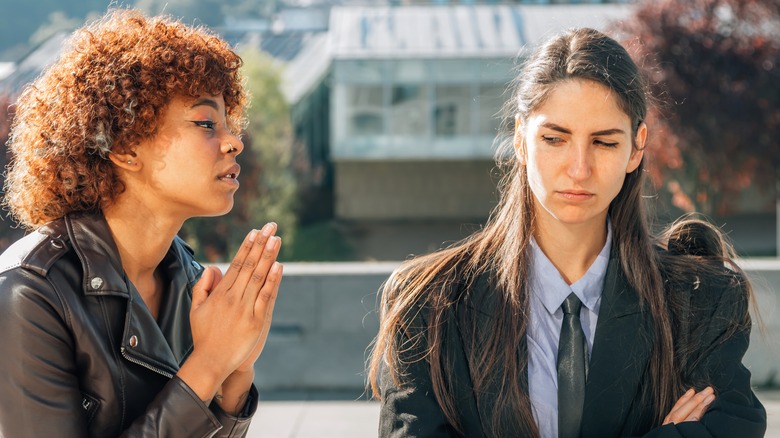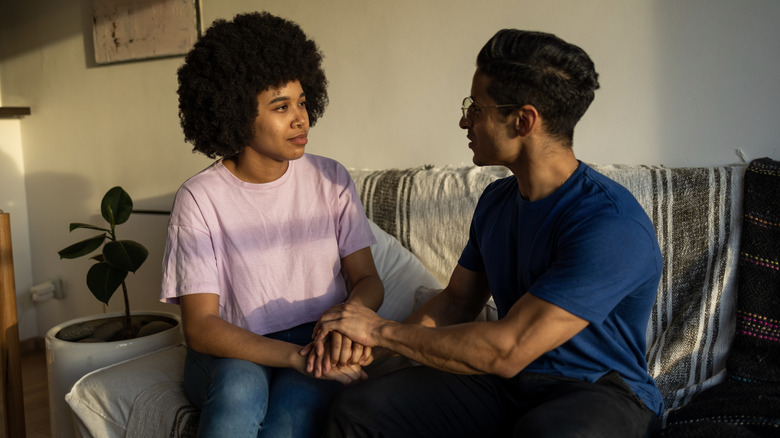Your Guide To The AAA Method Of Apologizing & Smoothing Over Any Messy Mistakes
Apologizing can be tricky, especially if you made a particularly horrendous slip-up. If your apology lands well, it can save a relationship, but if it's not executed carefully, it might just deepen the wound. That's why it's crucial to be thoughtful when delivering an apology and to help you get it right, communications expert and author Matt Abrahams has a trusty method.
Abrahams shared his technique, called the AAA method, with Stylist: "In a nutshell, the AAA method is your ticket to saying sorry in a way that actually means something. It might not be a one-size-fits-all thing, but Acknowledge, Appreciate, and Amends are the secret sauce for crafting apologies that fix things up and keep your connections strong."
According to the pro communicator, admitting your mistake, recognizing its consequences, and taking measures to do better next time are the must-do steps to repair the damage after a blunder. And while Abrahams' approach is geared toward workplace mistakes, it can be applied to any situation, from romantic ruptures to making up with your best friend.
Own up to your mistakes
The first thing you should know about apologies is that they won't work if you don't know (or admit) what you did wrong. As Matt Abrahams explained to Stylist, you can't simply apologize for the other person being hurt — you have to directly acknowledge your wrongdoing. "No beating around the bush here. It's time to point out exactly what we did wrong and take full responsibility without any fancy footwork," he added. If you believe the other person played a role, leave that out of the conversation for now, as Karina Schumann, an associate professor of psychology at the University of Pittsburgh and apology researcher, told Time. Instead, focus solely on your part without pointing any fingers.
After you've acknowledged your mistake, the next step in the AAA method is to appreciate its impact on the other people involved. "We're talking about putting ourselves in their shoes and realising the emotional toll our blunders took," Abrahams explained to Stylist. This step can be hard, especially if you're still feeling embarrassed about your faux pas. But expressing empathy with a phrase like, "If someone did that to me, I'd feel frustrated too," can show them that you truly understand the effects of your actions.
Commit to righting your wrongs
Perhaps the most important part of saying sorry is committing to not repeating the same mistake again. In Matt Abrahams' AAA method, this is the Amends step. "Now comes the part where we talk about what we're going to do to make things right," he told Stylist. "It's not just about saying sorry; it's about showing you're serious about making things better." This communicates that you're truly remorseful and open to improving your behavior.
The best way to go about it, according to Abrahams, is to be specific. Don't just say, "I won't do it again." Explain exactly how you plan to avoid a similar mishap, such as by only canceling the day (not mere hours) before meeting up with a friend or talking to your manager before making big client decisions.
Even if you've put a lot of thought into how you'll do things differently next time, the other person might not be ready for an apology yet. "Everyone has a right to say, 'I need to think about what you said,'" Susan McCarthy, author of the book "SORRY SORRY SORRY: The Case for Good Apologies," shared with Good Housekeeping. If they're not open to accepting your apology, or if they ignore you when you reach out, McCarthy suggested making no more than three apology attempts. Remember, not all messy mistakes will be forgiven, but they can still be an opportunity for reflection and personal growth.


